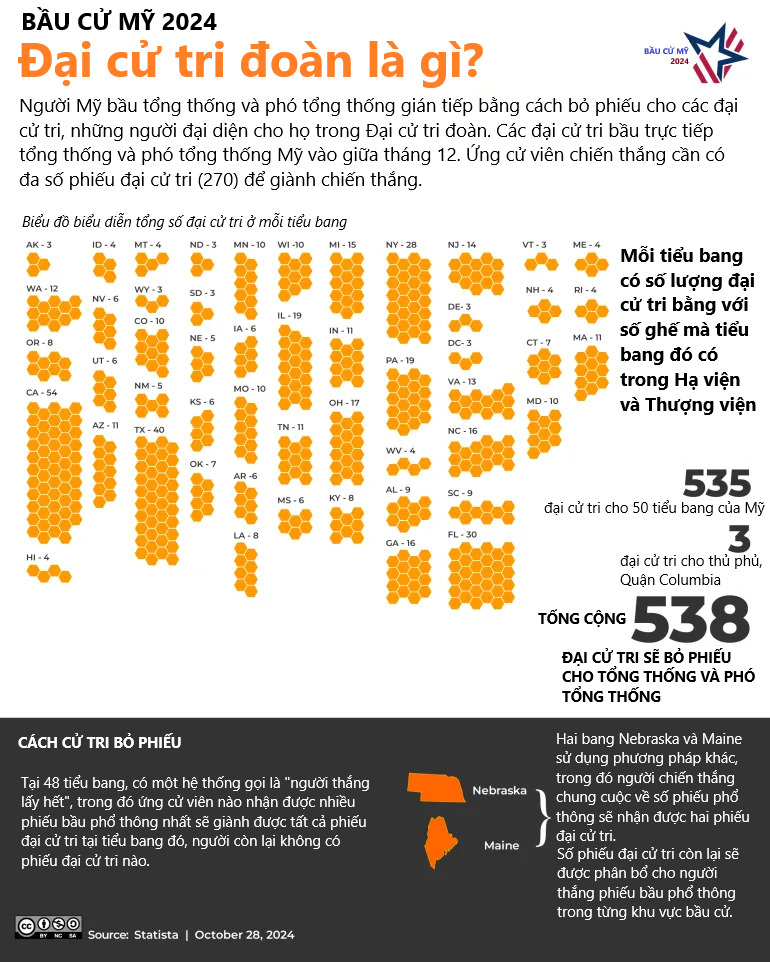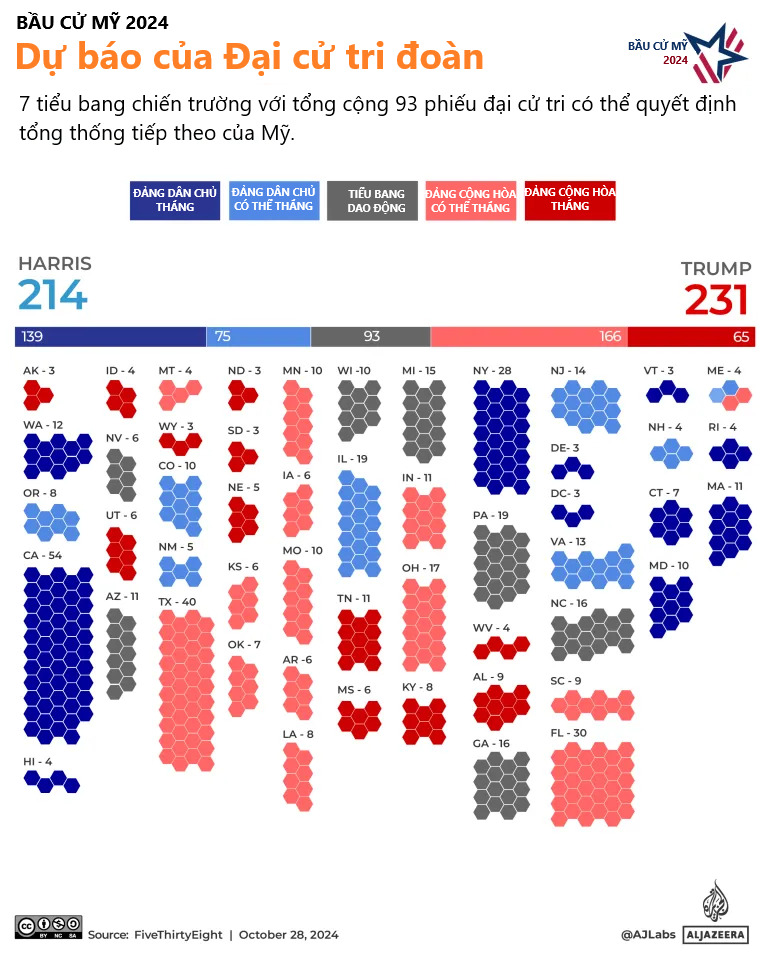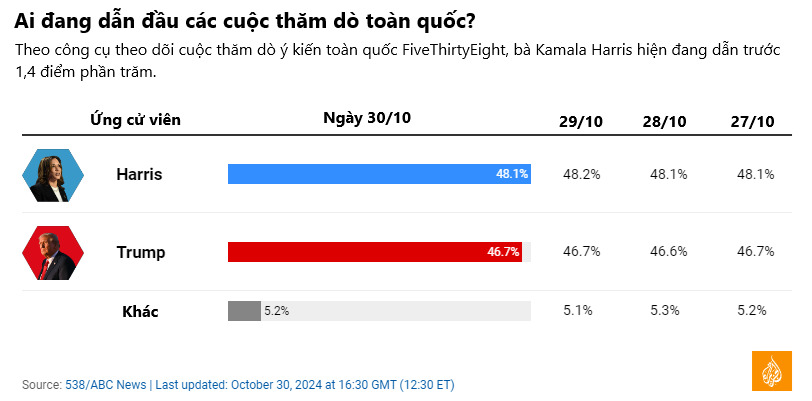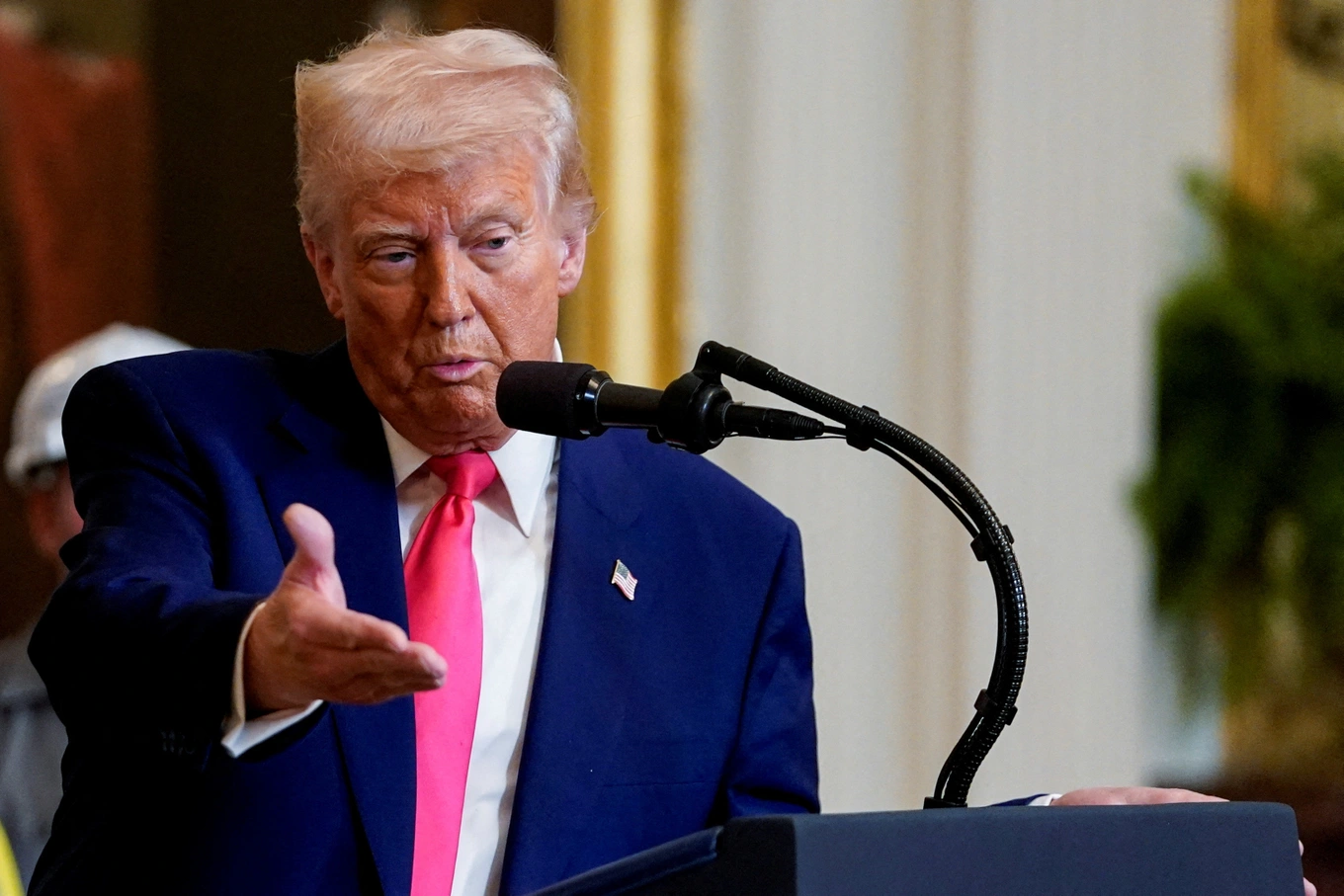(CLO) Election Day in the US is less than a week away. Below are simple information and graphics explaining the 2024 US Presidential vote.
Who can vote?
In the United States, citizens must meet certain basic eligibility criteria to vote. They must be US citizens, residents of the state where they are registered to vote, and must be 18 years of age or older.
Voting rights can vary from state to state, especially when it comes to criminal convictions. For example, individuals with criminal records may be subject to restrictions in some states, including permanent loss of voting rights.
There are about 160 million registered voters, but not all of them will turn out. In the 2020 election, voter turnout was only about 66%, although it was the highest in more than a century.

The debate between Republican presidential candidate Donald Trump and Democratic presidential candidate Kamala Harris is shown on a screen at a restaurant in Washington, DC, September 10. Photo: AFP
How does the US election work?
American politics is dominated by the center-left and liberal Democratic Party; and the right-wing and conservative Republican Party. Potential candidates from each party compete to represent their party in the presidential election.
To select candidates, the Democratic and Republican Parties hold primaries or caucuses in each state, ending with the winner accepting the nomination at the Republican or Democratic National Convention.
The process pitted Democratic Vice President Kamala Harris against former Republican President Donald Trump this year.
US President Joe Biden initially sought re-election for a second term, but he dropped out in July after a disastrous debate performance raised doubts about his ability to lead for another four years.
There are also third-party or independent candidates, such as the Green Party's Jill Stein, the Libertarian Party's Chase Oliver and anti-war scholar Cornel West.
During the election, presidential candidates nominate their running mates, in this case Democratic Minnesota Governor Tim Walz and Republican Ohio Senator JD Vance, who would become vice president if their presidential candidate wins. Voters then vote for president and vice president, and the results of these votes are then passed on to the Electoral College.
Since 1845, US elections have been held on the first Tuesday of November. However, voters can also vote early in most states, and more than 52 million votes have been cast.
How does the Electoral College work?
To understand how elections work in the United States and how voters elect their next leader, it is necessary to understand the US Electoral College.
Unlike members of the US Congress, who are directly chosen by voters, the US president is not elected by a direct national vote. Instead, when Americans vote, they are choosing a slate of "electors" from their state.
Electors are people who have pledged to vote for specific presidential and vice presidential candidates. After the votes are counted and certified, these electors officially vote for the president and vice president they have pledged to support.

Graphics: AJ
How many electoral votes does it take to win an election?
It takes 270 electoral votes out of a total of 538 available electoral votes to win the US presidential election.
The system can produce surprising results. A candidate who wins the national popular vote but loses the Electoral College has lost the election five times in U.S. history. The most recent example was in 2016, when Trump won the presidential election against Hillary Clinton despite losing the national vote by nearly three million votes.

Graphics: AJ
What do the polls say?
As Election Day approaches, Ms. Harris and Mr. Trump are neck and neck, competing fiercely for control of key swing states.
According to FiveThirtyEight’s polling tracker, Harris has a narrow 1.5-point lead nationally, though Trump has nearly closed the gap. A Reuters/Ipsos poll showed Harris with a lead of just one point, within the margin of error.
Mr Trump leads on economic and immigration issues, while Ms Harris has the edge on political extremism and abortion rights.
Swing states, or battlegrounds, like Pennsylvania, Georgia and Arizona are showing close margins. While national polls favor Harris, the Electoral College outcome remains uncertain, reflecting the unpredictability of the election.

When are the results announced?
That's not certain. It's highly unlikely that a winner will be determined on election night. But it's not impossible. Traditionally, a winner is announced the night or morning after the election.
As polls close across the country on Election Day, media outlets will report results in real time. Final vote counts may not be available immediately, especially as the volume of mail-in and absentee ballots increases. In some cases, states have laws that allow ballots postmarked by Election Day to be counted even if they arrive later. This process can lead to delays in some states.
If no candidate receives 270 electoral votes, a runoff election occurs. The House of Representatives elects the president, with each state casting one vote, and the Senate elects the vice president. A House candidate needs a majority (26 states) to win. This rare process last occurred in 1824, when former President John Quincy Adams was elected by the House after candidate Andrew Jackson won the most popular and electoral votes, but not an absolute majority (over half).
Hoai Phuong (according to AJ)
Source: https://www.congluan.vn/bau-cu-my-con-5-ngay-do-hoa-va-thong-tin-giai-thai-cach-don-gian-ve-cuoc-dua-vao-nha-trang-post319317.html

































![[Photo] "Beauties" participate in the parade rehearsal at Bien Hoa airport](https://vstatic.vietnam.vn/vietnam/resource/IMAGE/2025/4/11/155502af3384431e918de0e2e585d13a)




























































Comment (0)